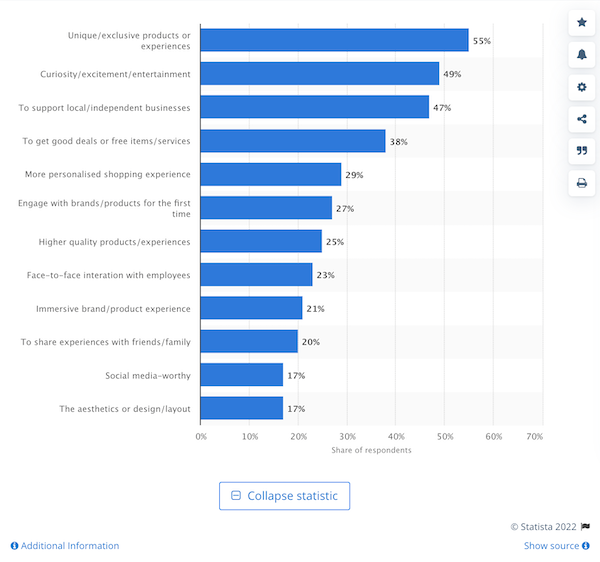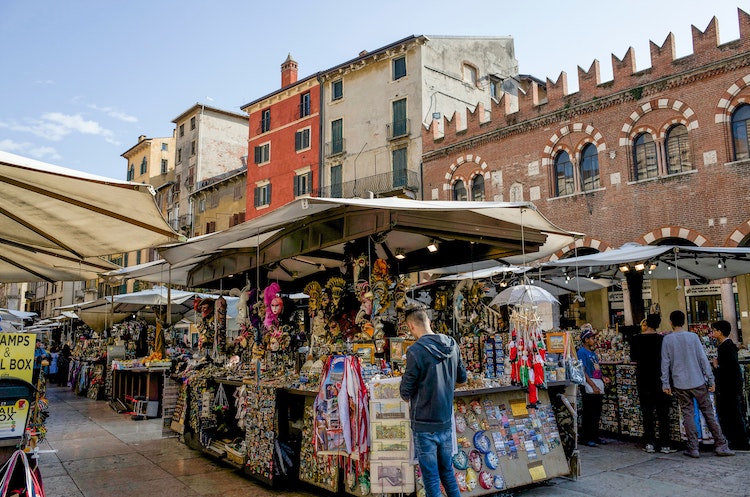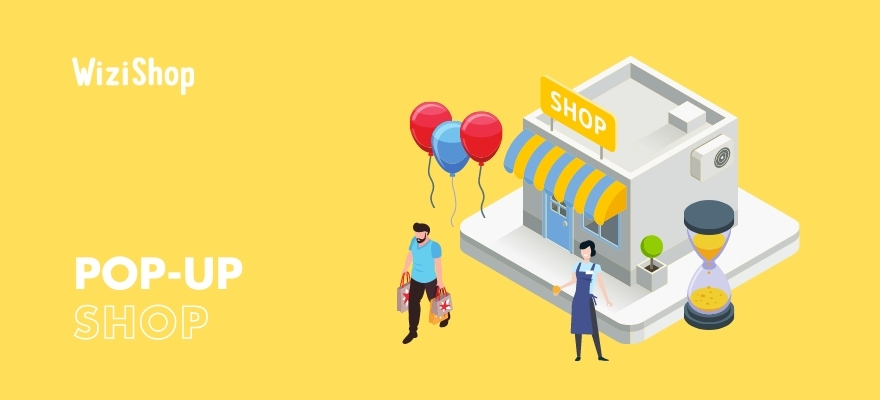Maybe you’re an ecommerce entrepreneur who’s considering creating a brick-and-mortar store to expand your business, but you’re worried about the risks. Or perhaps you simply want to try a new strategy to help promote your online store and increase brand awareness.
Either way, opening up a pop-up shop is a great way to explore new avenues for your ecommerce business. This type of short-term retail is becoming increasingly popular with online-store owners around the world, especially after being cooped up inside due to pandemic lockdowns
In this article, I’ll explain exactly what a pop-up shop is, describe why it’s great for ecommerce, and provide you with some helpful advice in getting started with one so that you can determine if it’s the right option for your brand.
What is a pop-up shop?
A pop-up shop, as the name hints, is a temporary physical sales site that “pops up” for a short period of time, anything from a few hours to several months, and then disappears.
Although short-term retail spaces have been around for a while, the roots of modern-day pop-up shops, also known as “pop-up stores,” “flash retailing,” and “temporary retail,” can be found in a 1997 Los Angeles event called The Ritual Expo, which was put together by media entrepreneur Patrick Courrielche.
This one-day affair was a big hit, combining music, food, and fashion to offer visitors a unique shopping experience. In fact, the event was so successful that well-known brands such as AT&T, Levis-Strauss, and Motorola later collaborated with Courrielche to launch similar experiences throughout the US.
Evolving over time, pop-up shops as we know them today often feature a special theme, promote a contest or specific product, and help businesses to build connections with a shiny new group of potential customers.
Pop-up shops can be found in a wide range of industries and can be adapted to nearly any type of product being sold.

What are the benefits of a pop-up shop?
So you’ve already got an amazing online store, and you’ve put a lot of effort into your digital marketing strategy…why on earth would you want to go offline, even temporarily?
Well, there are actually numerous benefits to running a pop-up shop. Unless you’re selling a super-niche product, you’re bound to have some competition in the market. Ecommerce entrepreneurs are increasingly needing to find new, creative ways to promote their businesses, reach their target markets, and stand out from competitors.
A pop-up shop is an excellent way to do all of these things and more.
Here are several of the top advantages that creating a pop-up shop can bring to your ecommerce business and why you may want to consider giving it a try today!
1. Increase brand awareness
If you’ve only recently launched your online store, you may need to spend some time getting the word out about your new business and building your ecommerce brand.
In addition to availing of a variety of both paid and free online marketing methods, opening a pop-up shop is another avenue to explore to let people see what you have to offer. This can be especially beneficial if you’re one of the first in your market to create a pop-up shop.
Take this strategy a step further by adding social media to the equation. For instance, you can promote your pop-up shop on your different social networks and encourage people who stop by to take photos and use a hashtag that you’ve created for your brand.
Even if your pop-up shop is only open for a couple of days, the buzz it can create for your brand can have a really positive impact in the long run.
2. Create a sense of urgency
For better or for worse, promoting urgency or scarcity is a sales tactic that’s been proven to work all around the world. I’m not sure any of us will ever forget 2020’s brief but intense shortage of toilet paper and hand sanitizer…
By their very nature, pop-up shops help create urgency because they’re temporary. Shoppers know that they won’t be around forever and feel more pressure to make a purchase before these temporary retail stores close.
You can also open a pop-up shop to promote an exclusive product or collection offered for a limited time to attract new customers.
Consider that in a Statista study of U.S. consumers in 2019, the top reason for visiting pop-up shops was due to shoppers’ desire for unique/exclusive products or experiences.

Source: Statista
Many shoppers love the idea of obtaining “limited-edition” items and will be all-the-more encouraged to visit your temporary physical store if they know that they can purchase special products there or enjoy a new experience for only a certain period of time!
3. Connect with customers in person
The convenience that online shopping provides for business owners and consumers alike is wonderful, but there’s something to be said for the face-to-face interactions and personal service that we experience when visiting brick-and-mortar stores.
The lockdowns, quarantines, and isolation brought on by the coronavirus pandemic have only made this desire for in-person connections stronger. As the owner of an online store, you can help fulfill this need by temporarily setting up shop somewhere that’s convenient for your target market and meeting current and potential customers face to face. Use this as an opportunity to show your audience the human side of your brand and build customer loyalty.
4. Attract new customers with a cost-effective marketing strategy
Although it may not be in your business plan or your budget to take on a 10-year lease for a physical storefront, renting a small space for a short period of time for your pop-up shop may be more feasible than you think.
With many businesses being forced to close their brick-and-mortar locations because of the pandemic, landlords are more likely to offer reduced rates, especially for short-term rentals, to prevent losing money on wasted space.
This makes it possible for ecommerce entrepreneurs to test a physical storefront at very little risk while allowing them to attract new customers and boost product sales.
5. Do a trial run for a possible permanent location
While the cost of running a pop-up shop can vary, the many options available make it possible for nearly any entrepreneur to give this marketing strategy a go. With little investment and little risk involved, it’s the perfect chance to experiment with certain aspects of your business that you may be unsure about!
If you’re thinking about expanding and opening a permanent physical location, you can use this as an opportunity to test the market and decide whether your business would be profitable there. If your first pop-up shop doesn’t do as well as you’d hoped, you can then determine if it’s due to the location or other factors and adapt your strategy accordingly.
6. Boost sales during busy periods
You’re of course free to open a pop-up shop any time of the year, but keep in mind that certain periods may prove to be more advantageous than others.
Depending on where your business and target market are located, holidays and sales periods such as Black Friday, Small Business Saturday, and Cyber Monday may be particularly profitable for your online store. Creating a pop-up store just before or during these periods to highlight a new product in your catalog can be excellent for sales.
Don’t forget about annual events that are unique to your location!
Local festivals, holiday markets, and other occasions that are well known in your community can be perfect for introducing potential customers to your business.

7. Experiment with new markets
Ecommerce is an ever-evolving creature—what works for your business in the beginning will likely require change years or even just months or weeks down the road. Hopefully you already performed some thorough market research before you launched your online store, but it’s important to continue researching if you want your business to grow.
Have an idea for a brilliant new product that you think is going to revolutionize customers’ lives? Before spending tons of money on product production, think about testing it out at a pop-up shop event first.
Similarly, say that you’re considering launching a new collection for your clothing line, for example.
You can create one or two new pieces to sell at your pop-up shop and obtain feedback from customers to get an idea of how successful the collection could be for your business or what improvements you could make.
8. Clear out slow-moving inventory
If you’ve got lots of old products taking up space in your home, office, warehouse, or wherever else you use for stock storage, this could be costing your business more money than you realize.
For instance, besides the costs required to store this inventory, there’s the revenue lost because these items aren’t selling.
The money you spend on holding on to old products could be better spent on other aspects of your business, such as advertising or new product development.
Make room for new goods by selling old stock at a pop-shop. This can be an especially good idea if your products have a limited shelf life or if they’re trendy items for which demand is likely to quickly decrease.
Pop-up shops offer the added benefit of allowing shoppers to see your products in person. This factor, combined with enticing product displays and special discounts or free samples, can help clear out dead stock in no time!
How much does it cost to run a pop-up shop?
There are so many factors that can affect the cost of launching and running pop-up shops that it’s very difficult to give a precise figure here. The large number of components involved means that costs can quickly add up, resulting in a venture that’s much more expensive than you’d originally planned.
However, this also means that there’s lots of room to adapt your pop-up shop to suit your business needs and fit your budget!
When working out a budget for your short-term retail adventure, the biggest factors to consider are the type of pop-up shop you want to run, location, size of the event space, and rental duration.
Types of pop-up shops
At this point, perhaps the idea of launching your own pop-up store is starting to sound pretty intriguing. To give yours the best chance of success, take the time to determine what you want to accomplish by selling to customers in a temporary retail setting.
This will then help you to figure out what type of pop-shop will work best for your business, such as one of the following popular kinds of events:
- New product launch: Celebrate a new product or collection with a party that’s as laidback or exciting as you want to make it! Depending on your budget, you might highlight your new item(s) at a cozy booth or go all out with an extensive affair featuring a DJ and catering.
- Influencer collaboration: Employ the power of influencer marketing to help promote your brand by partnering with an influencer who’s well known in your target market. This person can create buzz for your event and boost attendance by talking about it to their followers on social networks beforehand. Even if visitors initially stop by just to snap a photo with the influencer, they’ll likely be curious to see what your store has to offer.
- Invite-only event: If an intimate event is more what you have in mind, consider creating an exclusive pop-up shop for a few bloggers or other people in the media to check out your products and spread the word about your business.
- Immersive experience: As we saw earlier in the Statista study, people LOVE unique experiences that they can’t find elsewhere. If you opt to create this kind of pop-up shop, be sure that the event makes sense for your brand. Demonstrations and workshops that allow for plenty of interaction generally work well here.
- Partnership with a sponsor: If your funds are limited, obtaining a sponsorship is one way to help bring your dreams of opening up a pop-up shop to life. Although your business may need to share the spotlight with the sponsor you’re partnering with, this type of event can get you lots of exposure and do wonders for your brand.
Choosing the location for your pop-up shop

One of the most important decisions you’ll need to make when you decide to launch a pop-up shop is where you want to have it. The space you select should make sense for your brand and your ideal customer. Of course, it also needs to fit your budget and be able to help you create the type of experience you want to provide for shoppers.
As you start to brainstorm location ideas for your temporary store, note that there are a number of options from which to choose.
For instance, vacant storefronts often work well, as they’ll likely already be set up for retail and may just need a few small adjustments to customize the space to suit your business. Shopping centers are also very common spots for pop-up stores. This is because they usually have lots of traffic and are often filled with people who are already in the mood to shop!
Depending on the weather, outdoor spaces, such as a booth in an open-air market may be the perfect choice for your temporary store. They tend to offer a more relaxed atmosphere, so just be sure that this suits your brand.
Unique event spaces, such as museums, art galleries, etc. can add a special touch to your pop-up shop and provide visitors with a memorable experience.
Finally, if the thought of remaining in one place for a long time isn’t your cup of tea, taking your pop-up shop on the road may be right up your alley! Rent a truck, van, or bus, and test out various locations with your mobile store.
What should you look for in a setting for your pop-up shop?
After you have a good idea of the type of space you’d like to use, the next step involves finding the specific location. As you go about your search, there are several things to keep in mind besides the big factors like rental cost and size of the space.
Exterior considerations
- Foot traffic: Is your pop-up shop in an area that people actually frequent? You may have snagged a great deal on the rent, but if your short-term store is out in the middle of nowhere, you might not have many visitors. Don’t forget to also ensure that the location is likely to attract the right kind of traffic—your target market!
- Neighboring shops: What other stores are in the same vicinity as where you plan to have your pop-up shop? If possible, stay away from sites where competing stores reside and instead look for locations with businesses that complement yours.
- Ease of customer access: What does your ideal customer require to not only be able to visit your pop-up shop but also enjoy the experience? Factors like parking, public transportation, and wheelchair accessibility are just a few of the elements to contemplate when making your location decision.
- Visual appeal: How clean and orderly is the exterior? If people walking by have a bad first impression from how the venue looks on the outside, they may decide to forego seeing what your business has to offer. The location you choose should ideally already look great or at the very least be easy for you to tidy up yourself.
- Signage: Are people going to be able to easily find your pop-up shop? See what the rules are for adding your own signs to the space and give yourself enough time to create professional-looking signage to direct traffic to your event if needed.
Internal considerations
- Lighting: What kind of lighting works best for your brand and the experience you’re attempting to give shoppers? Your products may display best in natural light or perhaps a dimmer space is a better option for your brand.
- Storage space: Does your venue have enough room to keep your pop-up shop looking organized and uncluttered? Ensure that your space appears professional by confirming that there’s adequate storage for all the products you plan on featuring.
- Security: Will you feel confident about leaving any products behind if your event lasts more than a day? Besides aesthetics, the security of your pop-up shop is a crucial factor. Cameras, high-quality locks, and strong security systems are all great things to have in place to guarantee that your products remain protected.
- Access to the internet: Does the space have high-speed internet and dependable WiFi? To run smoothly, your pop-up shop will require internet access for processing sales transactions and making it possible for visitors to check out your website and share photos/videos of their experience in real time.
What’s next?

Once you’ve got everything planned for your pop-up shop and you’ve locked down your location, you need to make sure that people know about it! After all, it’d be a shame to pour loads of time and money into your project and not have any visitors.
Of course, the type of strategy you use to market your event will depend on your audience and budget. Nevertheless, social media is always an excellent place to start.
Allow yourself plenty of time before you launch your pop-up shop to tell potential customers about it on your different social networks and create some buzz. Share behind-the-scenes content to pique your followers’ curiosity and consider partnering with an influencer to assist with the build-up.
During your pop-up shop’s run, keep the energy high with music that matches the mood you want to create, and encourage visitors to post about your event on social media. You can also grow your email marketing list by collecting email addresses when visitors make a purchase.
Afterwards, make the most of user-generated content and highlight your customers’ experiences at your pop-up shop on your various channels to increase engagement and even generate interest for future events!










